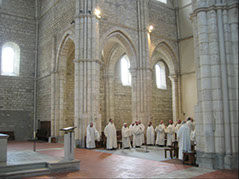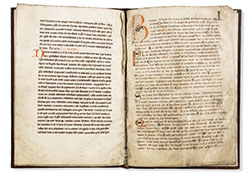













MONASTERY

Citeaux Abbey

12th century illuminated manuscript | France
With the arrival of the charismatic and energetic Bernard de Fontaine
at Citeaux…
the Cistercian Order rapidly expanded beyond its origins in France and into an international network of monasteries throughout medieval Europe,
comprising more than 300 houses at the time of
his death in 1153.
A HISTORY OF THE ORDER
THE CISTERCIANS OF THE STRICT OBSERVANCE is a Catholic monastic community of men and women ordered to a life of prayer, work and contemplation, living according to the Rule of St. Benedict, and founded at Citeaux near Dijon, France in 1098 by a group of monks under the leadership of Robert of Molesme. He and his companions were motivated by a desire to achieve a balance of
prayer and work in faithful obedience to the Rule and the monastic tradition of
the Desert Fathers, with emphasis on a simple lifestyle of poverty and detachment, dedicated personal and communal prayer, solitude and manual labor
inspired by the community life of the first Christians as described in the Acts of
the Apostles [2:42-47].
Under the leadership of Robert and his immediate successors, Citeaux gradually
evolved into a group of monasteries united by the Charter of Charity, which
provided a legal structure harmonizing central and local monastic authority.
Each Cistercian house remained independent under its elected abbot yet
strongly united to the others by bonds of fraternal charity and a common daily
rule of life.
With the arrival of the charismatic and energetic Bernard de Fontaine at Citeaux
fifteen years after its foundation, and his subsequent election as the influential
abbot of its daughter house at Clairvaux, the Cistercian order rapidly expanded
beyond its origins in France and into an international network of monasteries
throughout medieval Europe, comprising more than 300 houses at the time of
his death in 1153. By the end of the 15th century, the expansion reached its
apex, with 750 houses in the Cistercian Order.
BUT DURING the following century, the Protestant Reformation reversed the
pattern of growth in England and Ireland with Henry VIII’s dissolution of the
monasteries and state confiscation of Church property. Threats from without
coincided with stress from within, as the fervor and desire which had inspired
the founders to more faithfully live the Rule of Benedict declined. In reaction to
the relaxation of Cistercian monastic practice, Armand Jean de Rance, the abbot
of La Grande Trappe Abbey in France, in 1663 led an aggressive effort to reform
and restore the Order by renewal of ascetic practice, austerity of diet, and
emphasis on communal discipline. Following these reforms, Cistercians became
known as “Trappists” [men] and “Trappistines” [women].
Although de Rance’s efforts were blessed with success, during the 18th century
continued existence of the Cistercians was threatened by the hostile
ecclesiastical policies in effect both in France and Austria during the French
Revolution, leading to the dissolution of monasteries and appropriation of
Church assets. As a result, the monks from these countries fled and sought
refuge, first in Switzerland and Russia, and then following Napoleon’s defeat
and exile returned to France to recover and reconstitute their heritage.
WHILE LIVING IN EXILE at the abandoned Carthusian monastery of La Val Saint in Switzerland, and anxious to insure the future of the Order, Abbot Augustine de Lestrange in 1803 sent twenty monks to found a community in North America. Although this first effort ultimately failed and they returned to France in 1815, a
single member of the group, Fr. Vincent de Paul Merle, remained behind in Nova Scotia engaged in pastoral work, and by 1819 had found a suitable site for a revived monastic community. With the support of Fr. Lestrange, then residing at the French monastery of Bellefontaine, five monks arrived to begin the New World foundation of Petit Clairvaux. Despite long years of hardship and struggle, by 1876 the monastery became self-governing, and elected its first abbot.
From these humble beginnings, the Cistercian Order in the United States has
since grown to include 15 monasteries and abbeys of 276 monks and 98 nuns. ✜
St. Benedict's Monastery | 1012 Monastery Road | Snowmass, Colorado 81654
970/279-4400 | EMAIL snowmasscoc@gmail.com